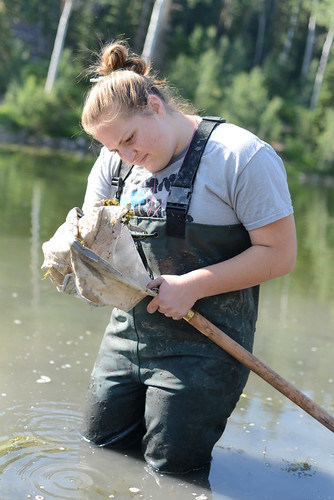
In a few short years, high school students at Nature High Summer Camp on the Manti-LaSal National Forest in Utah may become newly minted natural resource professionals who make a difference in the world of natural resources.
The 30 high-school students from Utah met as strangers on a Monday morning, but left Saturday as good friends who connected with nature in a way they had never before experienced.
“It’s amazing to see the changes in the students over the course of a week,” said Sierra Hellstrom, camp director who works in the U.S. Forest Service’s Intermountain Region. “They arrive shy and scared, with little knowledge of public land management. They leave enlightened and a very tight-knit group, and have a hard time saying goodbye to one another.”
The 22-year-old camp, a partnership with several government agencies, introduces students to “a day in the life” of a natural resource professional to learn about the complexities of public land management.
They work with silviculturists – or forester – to learn how to core trees to gather information on the age of stands (grouping of trees), health of trees, and other vital information.
Working with biologists, students learn about aquatic insects and how their presence – or absence – can reveal water quality. Students don waders and spend a morning catching samples in nets to identify and then interpret what they have discovered and how that relates to the entire watershed.

A soil scientist helps the students get literally dirty by digging a plot of soil so they can study the layers, the health of the surrounding area and other variables that affect how the soil is compacted.
A hydrologist and students carrying high-tech instruments wade into the water to test stream flow, temperature and other factors to determine spring run-off numbers and how they will affect the water supply throughout the summer.
Then they hike through the forest with an entomologist to learn that a very small insect – a bark beetle – in large numbers and under the right conditions can kill millions of trees. The students collect insect samples then return to camp to study them.
The students, by working in the field with professionals, also learn how science contributes to public policy and the eventual decisions that shape the public’s use of 193 million acres of national forests and grasslands.
“We cram a lot into a small period of time,” Hellstrom said. “But each segment is important. We can only hope that during that week we planted a seed in the minds of these young people who may see natural resources as a viable career choice. At the very least, we hope that they grow into adults who understand the connection between the natural world and our everyday lives.”
The success of camp is also measured by how many students eventually find internships, summer work or volunteer opportunities with natural resource agencies.
Perhaps the success of the program can best be summed up with a written critique from a camper: “I have a new outlook on life and people in general. We really can make a difference.”




